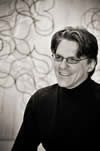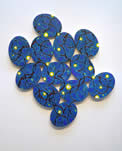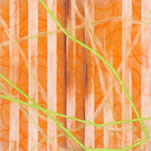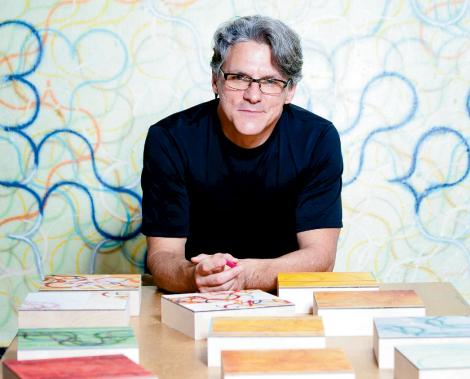March, 2006
WNC Woman Magazine
Profile: Kenn Kotara
“Left foot, right foot, heart beat. Otherwise it gets too complicated.”
The music of Philip Glass greets me as I enter an enviable painter’s studio in North Asheville.
Light enters through high clerestory windows, beneath a ceiling that must be at least 16 feet at its peak. As usual, I don’t know where to look first. A large painting in process almost obscures one wall, tantalizing 3 dimensional works hang suspended from their own metal racks, and the completed canvases stacked on shelves hint at a many-yeared progression of ideas, styles and concepts. But my interest is even more piqued when Kenn Kotara tells me he comes from a nonart family.
“If that means it wasn’t part of your development, then this is amazing,” I reply, looking around me. “What was it that opened your mind to the idea of art?”
“My first visit to a museum in Dallas at the age of 28. Music, the sound of Kansas because it’s so orchestrated and complex and exacting; Philip Glass because it’s repetitious, like mowing the lawn one blade at a time. Now I only listen to music about half the time, I prefer the sound of the brush on canvas, pencil on paper, my own breathing. Left foot, right foot, heart beat. Otherwise it gets too complicated.
“Hold it, hold it! Let’s get back to the museum visit. You were 28? Seriously?”
“I started to draw well at a very young age and by the time I was ready for college my parents didn’t know what to do with me. So I started out in architecture school. As my Dad said, “That way you can make a living and paint on the weekends.” But in the fourth year of a five-year program I quit?It just wasn’t for me. After that, I roamed around Louisiana for a while, and at the advanced age of 28, came back to school and finished with a BA in graphic design. Right after I got my degree, an advisor mentioned there was an opening for an assistant in the graduate MFA program and I leapt at it. Who could pass up a chance to go to art school and get paid for it? To my amazement they accepted me and I enrolled in my first ever drawing program.”
“1990 to ’93 were the most enlightening years of my life. In the first year, at my first review, my professors tore me apart. 45 minutes of it, one after the other, all saying the same thing, “Sure you can draw?but you don’t know how.” I went home and did what anybody would?drank a lot of beer and fell asleep feeling sorry for myself. But at 7:30 the next morning my advisor called with the dread question: “What are you going to do?”
(I do a quick reality check: fabulous studio, hundreds of canvasses, a member of the Asheville Public Art Board whatever he did, it must have been right.)
“You’re going to take two weeks off,” his advisor said without waiting for an answer. “And you’re going to think about allowing yourself to fail at drawing.” He smiles in rueful reminiscence. “By the time I came back to school, I understood for the first time that by playing it safe, all I’d managed to do was the same thing I’d always done. By allowing myself to fail, I was able to open the door to new possibilities.”It strikes me as a perfect time to look at the artwork and talk about the present. His work is clearly abstract, done in varying combinations of pencil, pastels and acrylics, (delete the) but his deep connection to the landscape of his native Louisiana is undeniable. I sense more than see the influence of rivers, bayous and lush vegetation?especially Spanish moss or “Barbe Espagnol” one of his recurring motifs. In his most recent work, there is an underlying theme of the emergence of organic images out of the strict order of geometric shapes. The result is evocative, a deeply personal embrace of chaotic transition. I am particularly delighted with his three dimensional interpretation of the “Barbe Espagnol” iimages. Here he has translated the trailing curves onto a series of fiberglass screens, closely hung so the viewer experiences them both as unit and individually.
Thirteen years after graduating from Louisiana Tech University, with a growing interest on the part of collectors, Kenn has trimmed his life down to the essentials, his art, his family and a passion for public art; and here we have a true meeting of the minds. As an active member of Public Art Board, Kenn believes the obstacle to art in Asheville is the lack of education. He considers it his mission to take the show on road. “People have such confused notions about art and artists,” he texplains. “It’s hard to know what to talk about first; that art is really a profession, that we have an artistic history in this country, or how we can use public art to bring together a community and take pleasure in our differences.”
“It’s amazing how few people, know about the rich heritage we have right here. We have the Black Mountain legend to show us what American art can be. If not for Albers, Cunningham,
Motherwell, Buckminster Fuller? Where would American art be today? ”
“Well where is it?” I ask, thinking of a hotly contested public sculpture that ended up in pieces in a scrap yard near where I used to live in Brooklyn. At the same time that it broke my heart to see it there, to this day I believe it was an honest reaction on the part of people who had to live with it every day, who didn’t understand the artist’s intention, and who were never part of the decision process for a purchase that was made with their own tax money? not unlike Asheville’s reaction to the acquisition of Ida Kohlmeyer’s Conversation Piece. The good news is, everybody knew about it, everyone was talking about it. With a little more education, the conversation can turn to the value of art that inspires controversy.”
“The point is to offer a new way to think about it,” he replies. “I did a presentation to a church group recently and showed slides of the Paley sculpture. Like many people in Asheville they didn’t like it, didn’t get it. Then I showed them a view from across the street, with a tree in the foreground, and pointed out the similarity between the pointed shape of the maple leaves and Paley’s forms. Several people came up to me later and told me that I had shown them a new way to look at art. I figure if we reach a few people each time we can make some progress, open some minds.”
I believe him. It’s about mowing the grass one blade at a time, left foot, right foot, heart beat. Kenn Kotara has shown extensively including solo shows at Gallery C in Raleigh NC, Sandler
Hudson Gallery in Atlanta, GA and the Upstairs Artspace in Tryon NC. His work, which has been reviewed in numerous publications, is in corporate and private collections from Asheville to Las Vegas to Sumisho, Japan. To see more of his work please visit: www.kotarastudio.com





